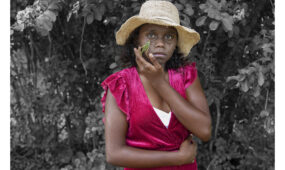Science sheds light on artistic experience
InReview

Neuroscientific knowledge of how the brain processes the separate attributes of visual images has expanded exponentially in recent years.
The mesmeric appeal of the artworks created by Australian new media artist Lynette Wallworth is explicable, at least in part, in terms of these developments.
Wallworth’s video work and installations, which have been exhibited internationally, are immersive in nature. They require viewers to become participants in her work and often to enter a new perceptual space.
Instinctively and artistically, Wallworth’s work resonates with a groundbreaking new concept in neuroscience: that as human beings we have, in fact, a number of visual “micro-consciousnesses”, rather than one singular, unified “visual consciousness”.
An exemplar of neuroscientific ideas
One of Wallworth’s most significant works thus far – Duality of Light (2009) – provides a useful example through which to explore these ideas.
Some of the following analysis is applicable to other Wallworth works as well, including Invisible by Night (2004), Beautiful Sunset (2006), Hold Vessel 2 and Evolution of Fearlessness (both 2007), Coral Rekindling Venus (2013), and her recent documentary, Tender (2013), all of which evince the artist’s ability to utilise the properties of light – luminance – and in some works, motion, in her art-making.
Duality of Light is designed to be experienced, ideally, by a single viewer at a time.
As one walks along a long, very dark, narrow passageway, to the hypnotic sound of water rhythmically dripping from cave walls, one unexpectedly encounters a digital version of a looming, life-sized figure walking towards oneself.
It takes some time to realise that this portentous ambulatory presence in one’s field of vision, heading towards oneself, is in fact oneself. The realisation is disquieting and, for many, confronting.
A short time after one’s encounter with oneself as a unified entity, this virtual self explodes (or implodes), shattering into tiny particles of shimmering light. The light disperses and disappears, and to quote Shakespeare, “the rest is silence”.
For participants, there is a delay in comprehending that it is actually the self that one encounters in Duality of Light.
The initial “mis-recognition” of oneself as oneself, or at least as a virtual iteration of oneself walking towards oneself, and the consequent sense of discombobulation that it engenders, is a general experience.
For some, including myself, such “mistaken identity”, the perceptual lag in self-identification, was relatively short-lived. Nevertheless, this perceptual delay, or time lag, in self-recognition explains the shock of recognition that occurs a little later.
The numinous presence in many of Wallworth’s artworks arises to a considerable extent from her adroit handling of the unique properties of light, colour, motion and sound.
To appreciate these phenomena at a deeper level, it is necessary to turn to neuroscience for further explanation.
Visual art meets neuroscience
The perceived nexus between visual art appreciation and neuroscience has been attracting increasing neuroscientific commentary.
Margaret Livingstone, Harvard professor of neurobiology, states on her university website that “a side interest in [our] lab is to use what we know about vision to understand some of the discoveries artists have made about how we see”.
Writing in 1994, the French neuroscientist Jean-Pierre Changeux asserted his intention “to foster further neuroscientific research in the field of art criticism, such as investigations of the possible neural origins of pleasure and artistic creation”.
The field is also garnering the interest of a number of Australian scientists working in research areas related to the human brain, such as Flinders University’s Professor Ian Gibbins.
Of particular significance to the understanding of three-dimensional visual and digital artworks such as Wallworth’s is new knowledge about the brain’s processing of animated visual information.
How we process motion and colour
Neuroscientists Andreas Bartels (Max Planck Campus, Tübingen University) and Semir Zeki (professor of neuroaesthetics at the Wellcome Department of Cognitive Neurology, University College London), have conducted research into how the brain processes distinct attributes such as motion and colour in anatomically (largely) segregated systems.
They have established that the “binding” of such attributes is subject to a temporal hierarchy. This means in practice that each element is subject to a tiny, but perceptible time lag in relation to one another. The researchers write that:
The attribute specific binding times are in line with our knowledge of the organisation of the visual system, where colour and motion are processed in largely segregated systems.
In 2008, Bartels, Zeki and Logothetis demonstrated in experimentation with humans watching moving images (feature films, in this instance) that visual changes, as is the case in real life, “can be partitioned into global flow due to self/camera motion, local/differential flow due to object motion, and residuals, for example, due to illumination changes”.
Tellingly, in relation to moving visual images, Bartels and Zeki had earlier demonstrated that the binding of such elements is not only asynchronous but is post-conscious. That is, it requires conscious effort on the part of the viewer to integrate all of the variables involved in what we call “seeing” into a single, seemingly unified experience.
Based on experimentation with human subjects, Bartels and Zeki also found that binding times depend on the specific attributes to be bound.
For example, where such binding occurs within attributes – that is, colour-colour or motion-motion – the binding period is more rapid than it is across attributes, in colour-motion binding for instance, where perceptual delays are longer. This is the case because different neural pathways are associated with each attribute. This has obvious implications for how we perceive moving images.
Such new understanding about how the brain processes visual information adds another level of complexity to our understanding of contemporary visual art involving moving imagery, colour and faces.
The time lags in our perception
Thanks to Zeki et al’s research, we now know that there are separate loci controlling micro-consciousness for colour, for the visual motion system, and for faces. In other words, the attributes of visual perception are not processed simultaneously – but asynchronously.
Although the time differences (or time lags) involved in processing the various different aspects of visual information are very small, nevertheless they’re significant in terms of the time taken for the human brain to process colour, motion, faces and sound. Colour is perceived before motion, for example.
Zeki explains in a 2003 article titled “The Disunity of Consciousness”: this perceptual asynchrony is not limited to colour and motion, because it has also been shown that locations are perceived before colours, which are perceived before orientations.
What this means is that there is a temporal hierarchy, with significant implications in terms of integrating the various elements that contribute to what we call “seeing”.
How Duality of Light affects our brains
Like visual information, auditory information is processed by the brain in different locations and at slightly different times. This also contributes to what Zeki has described as “the disunity of consciousness” and certain new media artists, including Wallworth, deploy this phenomenon to great effect, albeit intuitively.
The visual material in Wallworth’s Duality of Light is accompanied by an auditory component (the sound of dripping stalactites inside a cave). The work therefore engages viewers’ use of several distinct visual processing loci, including those dealing with colour, motion, and facial recognition, as well as an auditory one. As a result of the sensory hierarchy involved, taken together, these elements are perceived by the viewer as “constitut[ing] a distinct new entity”, to borrow Zeki’s terminology.
The perception that a “new entity” has appeared before us in Duality of Light is a product of the temporally hierarchical relationship of the individual visual and auditory elements to one another.
This accounts for the initial sense of disorientation we experience in Duality of Light. That’s followed by the post-conscious realisation, after our brains have “bound” these individual elements, that one has actually come face to face with one’s own image.
The experience accords with Zeki’s explanation that we humans have separate micro-consciousnesses that need to be integrated – as opposed to a single, sovereign macro-consciousness.
Light, luminance, and the properties of light and motion are major foci of Wallworth’s artistic attention and curiosity, contributing maximally to the distinctive ambience of her visual artwork.

Get InReview in your inbox – free each Saturday. Local arts and culture – covered.
Thanks for signing up to the InReview newsletter.
Such knowledge of the inner workings of the human brain shouldn’t diminish our admiration for artistic accomplishment or appreciation of Wallworth’s work but rather intensify it.
Christine Nicholls is a senior lecturer at Flinders University. This article was first published on The Conversation.
Support local arts journalism
Your support will help us continue the important work of InReview in publishing free professional journalism that celebrates, interrogates and amplifies arts and culture in South Australia.
Donate Here





Comments
Show comments Hide comments